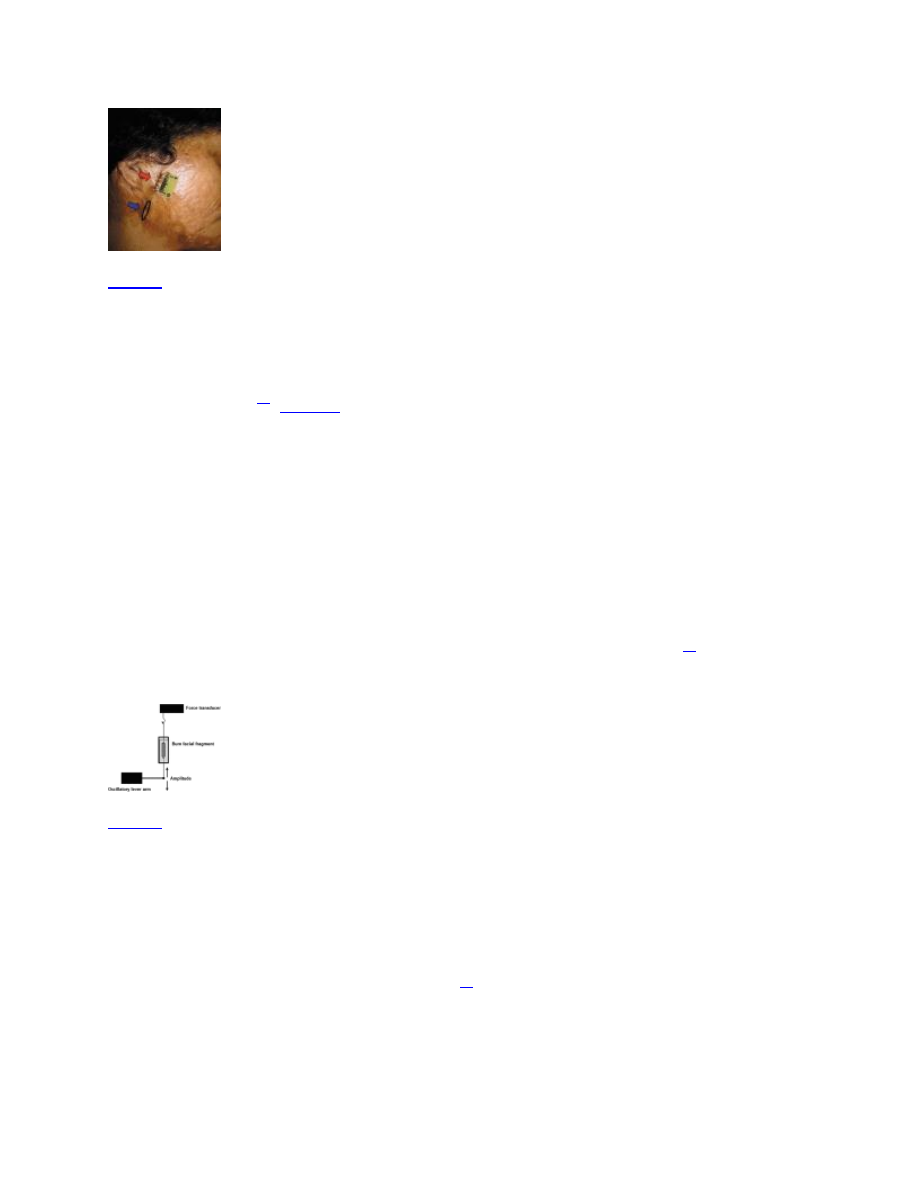
Mechanical evaluation of the resistance and elastance of post-burn
scars after topical treatment with tretinoin
I
III
IV
IV
Paulo Hilário Nascimento Saldiva
IV
and
Copyright and License information ►
This article has been
Abstract
OBJECTIVE:
After burn injuries, scarred skin lacks elasticity, especially in hypertrophic scars. Topical
treatment with tretinoin can improve the appearance and quality of the skin (i.e., texture,
distensibility, color, and hydration). The objective of this prospective study was to examine the
effects of treatment with 0.05% tretinoin for one year on the biomechanical behavior and
histological changes undergone by facial skin with post-burn scarring. Setting: Tertiary,
Institutional.
METHOD:
Fifteen female patients who had suffered partial thickness burns with more than two years of
evolution were selected. Skin biopsies were obtained initially and after one year of treatment.
The resistance and elastance of these skin biopsies were measured using a mechanical oscillation
analysis system. The density of collagen fibers, elastic fibers, and versican were determined
using immunohistochemical analysis.
RESULTS:
Tretinoin treatment significantly lowered skin resistance and elastance, which is a result that
indicates higher distensibility of the skin. However, tretinoin treatment did not significantly
affect the density of collagen fibers, elastic fibers, or versican.
CONCLUSION:
Topical tretinoin treatment alters the mechanical behavior of post-burn scarred skin by
improving its distensibility and thus leads to improved quality of life for patients.
Keywords: Burn scars, Topical treatment, Tretinoin, Physical property of skin

INTRODUCTION
The evolution of medical knowledge and techniques, including improved intensive care units and
surgical procedures, has increased the survival of major burn patients.
Burn victims live with sequelae that may decrease their self-esteem and, therefore, their quality
of life. A specialized multi-disciplinary professional team that can treat the multiple aspects of
rehabilitation is critical for the proper re-integration of patients into their familiar professional
and social environments. Post-burn scars induce profound changes in skin structure, such as
epidermal and dermal abnormalities. Within the dermis, changes in the extracellular matrix
(ECM) include increased concentrations of collagen fibers, which can be arranged in whorls or
nodules, and decreased levels of elastic fibers.
Versican, a proteoglycan with hydrophilic
properties, is usually present in large amounts in recent hypertrophic scar tissue. As the scar
matures and becomes less rigid, the amount of versican decreases.
After tissue repair, alterations
in ECM composition and organization lead to changes in the mechanical properties of the skin
that result in decreased elasticity, especially in hypertrophic scars.
, The severity of these
changes varies, depending on the depth of the original injury and other factors. When
spontaneously restored, burns that involved deep dermal injury can take from three to five weeks
to epithelize completely. Injuries that take longer to epithelize are more likely to evolve with
hypertrophy.
Due to the limitations of surgical techniques, many burn patients require additional treatment to
improve the texture and appearance of their skin.
The use of topical tretinoin improves the
appearance of keloids and hypertrophic scars and seems to increase skin elasticity in scar
sequelae.
The topical use of tretinoin with glycolic acid in both restored skin and in grafted
skin has been shown to increase the extent of mouth opening in burn patients with facial
scarring.
Several studies addressing the properties of post-burn scars or their cicatricial sequelae have
characterized the tegument qualitatively by examining coloration, smoothness (texture,
flexibility), or thickness. Previous authors have highlighted the importance of using objective
measurements to analyze skin mechanical properties with such equipment as linear
extensometers or cutometers (devices that measure cutaneous elasticity by suction).
Measurements of skin elastance have been used in studies assessing the mechanical properties of
the skin in patients with systemic sclerosis.
Using an instrument called an “elastometer,” the
skin elastance of these patients was found to be significantly greater than that of control
individuals. In addition, this measurement was correlated with clinical scores that indicated
thickening.
In our hands, these devices (i.e., extensometers, autometers, and elastometers) did
not provide homogeneous measurements when we attempted to reproduce these data in pilot
studies. An alternative method of measuring the mechanical oscillation of tissue using a
computer to record tissue resistance and elastance has been described for analyzing lung tissue in
various diseases.
The mechanical oscillation of tissue has been used previously to assess the
viscoelastic properties of the superficial aponeurotic muscle system in rhytidoplasties
, but it
has not yet been used for skin.

To investigate more accurately the reported improvements in the distensibility of post-burn
scarred skin after topical treatments with tretinoin, we examined skin tissue using mechanical
oscillation analysis to measure biomechanical behavior and immunohistochemistry to study
possible mechanisms underlying these improvements.
METHODS
Fifteen female patients between 18 and 40 years of age (mean age = 26.7) were included in the
study. These patients exhibited residual facial scars resulting from superficial partial thickness
facial burns that had been caused by ethanol and spontaneously restored with conservative
treatment two or more years before. All patients signed an informed consent form approved by
the Review Board and Ethics Committee of the institution in accordance with the Declaration of
the World Medical Association (number 515/5). Exclusion criteria included previous surgeries,
corticosteroid treatment, keloid scars, systemic diseases, pregnancy, and smoking. All patients
were instructed to use contraceptive methods because of the potential teratogenic effects of
tretinoin.
All selected patients had whole-face scarring. At the beginning of the study, we performed an
initial biopsy of the injured skin of each patient in the pre-auricular (“non-treated”) region. The
patients received a supply of tretinoin hydroalcoholic solution (tretinoin – 0.05%; propylene
glycol – 5% and alcohol 50% - 20 ml) to be used every night on the face.
Patients were instructed to wash their faces at night with water and neutral soap. After washing,
they were to apply five drops of the tretinoin solution over their faces without massaging. In the
morning, they were instructed to wash their faces again. This procedure was to be performed
once daily for one year, unless clinical signs of dermatitis (i.e., erythema or redness) appeared. If
dermatitis was observed, they were instructed to interrupt the treatment and to call the
researchers. To minimize bias in the study, patients were instructed not to use sunscreen but were
strongly advised to avoid sun exposure and to use mechanical sun protection, such as hats and
umbrellas.
To ensure adequate treatment and to check for possible complications, such as signs of dermatitis
(e.g., redness or itching), patients were required to visit the hospital weekly during the two first
months of treatment and bimonthly over the following ten months. After one year of treatment, a
second biopsy of the injured skin was taken, from a point 1 cm below the ear lobe (“treated”) and
at least 1 cm from the first biopsy scar. We chose to perform the two biopsies on the same side of
each patient's face to ensure similar scar quality when comparing treated versus non-treated skin
(

Pre-treatment biopsy (superior arrow) and planning for the post-treatment biopsy (inferior arrow).
Skin strips were obtained from the biopsies (10.0×2.0×2.0 mm each) and were subjected to
oscillatory mechanical analysis, and resistance (R) and elastance (E) were measured, as
previously described
). Briefly, the resting length (Lr) of each strip was first
measured. Metal clips were glued to either end of the tissue strip with cyanoacrylate. Steel wires
(0.5 mm in diameter) were attached to the clips; one end was connected to a force transducer
(Model 404A; Cambridge Technologies), and the other end was connected to a servo-controlled
lever arm (Model 300B; Cambridge Technologies). The lever arm was connected to a function
generator (Model 3030; BK Precision, Chicago, IL), which controlled the frequency, amplitude
and waveform of the oscillation. The resting force (T) was set by movement of a thumb-wheel
screw system, which effected slow vertical displacements of the force transducer. Length and
force signals were converted from analogue to digital and recorded in a compatible computer.
The oscillation frequency was 0.1 Hz (six excursions per minute), and the amplitude was 1% Lr.
Estimations of R and E were determined by applying the recursive least-squares algorithm to the
equation of motion: T = EΔl+R (Δl/Δt)+K; where R = resistance, E = elastance, T = force, l = length,
Δl/Δt is the change in l per unit time, and K is a constant reflecting resting force
. Resistance
and elastance measurements were recorded for ten minutes.
Schematic of the mechanical tissue analysis. Skin strips were suspended in a solution and connected to a
force transducer and an oscillatory lever arm for measurements of resistance and elastance.
After the mechanical oscillation, the strips were fixed in 10% formalin and embedded in paraffin
for histological analysis. Next, 5-µm-thick slices were stained with Sirius red and resorcin-
fuchsin to identify total collagen and elastic fibers, respectively. Type III collagen fibers and
versican were stained by immunohistochemistry.
Using image analysis software (Image-Pro®
Plus 4.1 for Windows®), we determined the densities of type III collagen fibers, total collagen
fibers, elastic fibers, and versican in the superficial, middle, and deep layers of the dermis.

Protein density was calculated as the relationship between areas of stained protein and total
tissue area and was expressed as a percentage.
The Wilcoxon test for paired non-parametric variables was used to compare the treated and non-
treated areas from each of the 15 patients. The level of significance was established at p<0.05.
RESULTS
All patients completed the entire tretinoin treatment. Five patients exhibited temporary clinical
signs of dermatitis (e.g., erythema, desquamation, pruritus) with spontaneous remission after a
one-week interruption of tretinoin use. Because they continued with tretinoin treatment after this
period, these patients were not excluded from the study. At the end of the study, three patients
exhibited post-inflammatory hyperpigmentation, one exhibited mild telangiectasis on the malar
region, and one had keloid development in the biopsy scar. The hyperpigmentations were later
treated with 4% hydroquinone and sunscreen for three months.
Significant decreases in the mean values of resistance (R) and elastance (E) were observed in
treated scarred skin compared to the non-treated scarred skin (p = 0.003 and p = 0.047,
respectively). The mean decreases in resistance and elastance after treatment were 31.4% and
14.8%, respectively (
Mean resistance values comparing treated and non-treated areas after one year of topical treatment
with tretinoin (p = 0.003).
Mean elastance values comparing treated and non-treated areas after one year of topical treatment
with tretinoin (p = 0.047).
There were no evident histological differences in the distributions of ECM components between
treated and non-treated specimens. The quantification of total collagen, collagen III, elastic
fibers, and versican content by image analysis did not reveal significant differences between
treated and non-treated specimens in any of the layers of the skin dermis.

representative photomicrographs of the post-burn scarred skin stained for total collagen fibers,
collagen III, elastic fibers, and versican. There were also no differences in epidermal thickness,
as measured pre- and post-treatment.
Photomicrographs of total collagen fibers (A), elastic fibers (B), collagen III (C) and versican (D) stained
for histological analysis (400X magnification).
DISCUSSION
There is a high demand for cutaneous treatment among burn patients. The skin is a
communication organ and is vital for the perception of the limits of an organism and for the body
image of an individual. Improvements in skin quality, especially in the face, can contribute to
increased self-esteem and quality of life for burn patients.
We have been using topical tretinoin to treat burn patients for more than a decade. Satisfaction is
high among the patients, especially with respect to the observed improvements in tegument
quality. The potential for topical treatments using tretinoin combined with glycolic acid to
improve the mechanical properties of scarred skin has been indirectly shown through mouth-
opening measurements.
In this study, clinical improvements in burned skin distensibility after
tretinoin topical treatment were demonstrated by a decrease in resistance and elastance, as
determined by biomechanical analysis. Tissue resistance represents the energy loss resulting
from the opposition to movement, and elastance (i.e., the inverse of compliance) is a measure of
the tendency of tissue to recoil toward its original dimensions upon the removal of a distending
or compressing force. Therefore, lower elastance (or greater compliance) corresponds to greater
distensibility in a given tissue.
In this study, the mechanical properties of burned skin with and without tretinoin treatment were
assessed by adapting a mechanical tissue oscillation method used for analyzing the mechanical
behavior of lung tissue in various diseases.
We are not aware of any other reports in the
literature in which this method has been used to evaluate post-burn scarred skin. The main
disadvantage of this method was the requirement for skin biopsies, which can lead to scar
complications. The potential cosmetic concerns associated with biopsies were largely avoided in
this protocol because the biopsies were taken from the center of existing burn scars and thus did
not cause additional scarring in patients. Additionally, the biopsies were not taken from an
extremely visible area.

Topical treatments with tretinoin have been shown to increase skin distensibility in post-burn
scarring and acne scars with high levels of patient satisfaction.
mechanisms underlying these clinical effects are not completely understood. Retinoids, such as
tretinoin, affect cell growth and differentiation and alter cell-cell cohesion. In the dermis,
tretinoin modulates ECM synthesis by fibroblasts and increases angiogenesis.
Scar bleaching and texture improvements achieved by topical treatments can promote secondary
improvements in self-esteem and quality of life.
Topical therapy with tretinoin should always
include sunscreen preparations to prevent hyperpigmentation, and patients should be encouraged
to avoid sun exposure.
Because of the potential teratogenic effects of tretinoin, patients
receiving this drug should use contraceptive methods.
The most common adverse effect of topical tretinoin is local and temporary cutaneous irritation
(i.e., “retinoid dermatitis”) characterized by erythema, peeling, dryness, and itching.
was observed in 20% of the patients in this study. This high incidence is probably related to the
high concentration (0.05%) of tretinoin that was used in this study. These cases were treated by
temporary interruption of tretinoin use, which resulted in spontaneous remission. Other adverse
effects included hyperpigmentation and increased telangiectasias in 5% of patients. We currently
prefer to use lower doses of tretinoin (0.025%) to minimize skin irritation.
Patients with facial burns with over two years of evolution were selected to avoid the period
when the spontaneous involution of the tegument occurs because of cicatricial process
maturity.
ECM remodeling depends on the equilibrium between fiber synthesis and
degradation. Collagen fibers are responsible for the tensile force of connective tissue, and elastic
fibers return the deformed collagen network to its previously relaxed condition through traction
forces. When elastic fibers are injured, there is a loss of elasticity. Additionally, maturation of
post-burn scars depends on the normalization of dermal proteoglycan levels.
production may be favored in the cicatricial tissue with the use of tretinoin, in keeping with what
is seen after the compression of hypertrophic areas.
The histological analyses and the quantitative assessments of collagen, elastic fibers, and
versican content performed in this study were not sensitive enough to explain the observed
changes in the mechanical behavior of the post-burn skin after treatment. The results and tables
with these comparisons are available in a doctoral thesis;
however, they were not referenced
here because they were not statistically significant. It is possible that the structural arrangement,
distribution and/or organization of the fibers play a more relevant role in determining the
mechanical behavior of the tissue than do the quantitative changes. In addition, it is possible that
the mechanical experiments may have disturbed the subsequent histological analyses. In the
previous studies performed in the lungs, this phenomenon was not observed, but it may be
beneficial to use different skin strips for mechanical and histological analyses in future studies.
Long-term maintenance of the beneficial effects of topical tretinoin treatment can be achieved
through sustained adherence to the recommended treatment regimen. This was observed in this
study, as patients completely adhered to the treatment to improve their appearances.

We conclude that topical treatment with tretinoin changes the mechanical behavior of the skin in
patients with facial post-burn scarring, thereby improving distensibility.
ACKNOWLEDGMENTS
The authors thank Dr. Luiz Fernando Ferraz da Silva for technical support with image analyses
and Claudia Garcia (RC Farmácia Dermatológica) for manufacturing the topical products.
Footnotes
No potential conflict of interest was reported.
REFERENCES
1. Santos SR, Campos EV, Sanches C, Gomez DS, Ferreira MC. Fluconazole plasma concentration
measurement by liquid chromatography for drug monitoring of burn patients. Clinics. 2010;65:237–43.
10.1590/S1807-59322010000200017 [
2. Braz LG, Braz DG, Cruz DS, Fernandes LA, Módolo NS, Braz JR. Mortality in anesthesia: a systematic
review. Clinics. 2009;64:999–1006. 10.1590/S1807-59322009001000011 [
3. Coelho da Mota DS, Furtado E, Bottino DA, Bouskela E. Effects of buflomedil and pentoxifylline on
hamster skin-flap microcirculation: prediction of flap viability using orthogonal polarization spectral
imaging. Clinics. 2009;64:797–802. [
4. Scott PG, Dodd CM, Tredget EE, Ghahary A, Rahemtulla F. Immunohistochemical localization of the
proteoglycans decorin, biglycan and versican and transforming growth factor-b in human post-burn
hypertrophic and mature scar. Histopathology. 1995;26:423–31. 10.1111/j.1365-2559.1995.tb00249.x
[
5. Kamath NV, Ormsby A, Bergfeld WF, House NS. A light microscopic and immunohistochemical
evaluation of scars. J Cutan Pathol. 2002;29:27–32. 10.1034/j.1600-0560.2002.290105.x [
6. Clark JA, Cheng JCY, Leung PC. Mechanical characterization of human postburn hypertrophic skin
during pressure therapy. J Biomechanics. 1987;20:397–406. 10.1016/0021-9290(87)90047-9 [
7. Krusche T, Worret W. Mechanical properties of keloids in vivo during treatment with intralesional
triamcinolone acetonide. Arch Dermatol Rev. 1995;287:289–93. 10.1007/BF01105081 [
8. Clark CP., 3rd Alpha hydroxy acids in skin care. Clin Plast Surg. 1996;23:49–56. [

9. Pownell PJ, Rohrich RJ. Burn reconstruction. Selected Readings in Plastic Surgery. 1998;8:10–37.
10. Salles AG, Gemperli R, Toledo PN, Ferreira MC. Combined tretinoin and glycolic acid treatment
improves mouth opening for postburn patients. Aesth Plast Surg. 2006;30:356–62. 10.1007/s00266-004-
0151-0 [
11. Isaac C, Carvalho VF, Paggiaro AO, Maio M. Intralesional pentoxifylline as na adjunvant treatment for
perioral post-burn hypertrophic scars. 2010;36:831–5. Burns. [
12. Hansen DA. Treatment of hypertrophic scars with retinoic acid. South African Medical Journal (SAMJ)
1979;22:1114. [
13. Janssen de Lipens AMP. The local treatment of hypertrophic scars and keloid with topical retinoic
acid. Br J Dermatol. 1980;103:319–23. 10.1111/j.1365-2133.1980.tb07251.x [
14. Mizutani H, Yoshida T, Nouchin N, Hamanaka H, Shimizu M. Topical tocoretinate improved
hypertrophic scar, skin sclerosis in systemic sclerosis and morphea. J Dermatol. 1999;26:11–7. [
15. Panabiere-Castaings MH. Retinoic acid in the treatment of keloids. J Dermatol Surg Oncol.
1988;14:1275–6. [
16. Balbir-Gurman A, Denton CP, Nichols B, Knight CJ, Nahir AM, Martin G, et al. Non-invasive
measurement of biomechanical skin properties in systemic sclerosis. Ann Rheum Dis. 2002;61:237–41.
10.1136/ard.61.3.237 [
17. Ballou SP, Mackiewicz A, Lysikiewicz A, Neuman MR. Direct quantitation of skin elasticity in systemic
sclerosis. J Rheumatol. 1990;17:790–94. [
18. Dolhnikoff M, Mauad T, Ludwig MS. Extracellular matrix and oscillatory mechanics of rat lung
parenchyma in bleomycin-induced fibrosis. Am J Resp Crit Care Med. 1999;160:1750–7. [
19. Lanças T, Kasahara DI, Prado CM, Tibério IF, Martins MA, Dolhnikoff M. Comparison of early and late
responses to antigen of sensitized guinea pig parenchymal lung strips. J Appl Physiol. 2006;100:1610–6.
10.1152/japplphysiol.00828.2005 [
20. Har-Shai Y, Bodner SR, Egozy-Golan D, Lindenbaum ES, Ben-Izhak O, Mitz V, et al. Viscoelastic
properties of the superficial musculoaponeurotic system (SMAS): a microscopic and mechanical study.
Aesth Plast Surg. 1997;21:219–24. 10.1007/s002669900113 [
21. Dolhnikoff M, Morin J, Ludwig MS. Human lung parenchyma responds to contractile stimulation. Am
J Respir Crit Care Med. 1998;158:1607–12. [
22. Lauzon AM, Bates HT. Estimation of time-varying respiratory mechanical parameters by recursive
least squares. J Appl Physiol. 1991;71:1159–65. [

23. Araujo BB, Dolhnikoff M, Silva LF, Elliot J, Lindeman JHN, Ferreira DS, et al. Extracellular matrix
components and regulators in the airway smooth muscle in asthma. Eur Respir J. 2008;32:61–9.
10.1183/09031936.00147807 [
24. Jenkins SC, Henke J. Retinoic acid modifies scars from self-injury by burning. Am J Psychiatry.
1993;150:1125. [
25. Balakrishnan C, Hashim M, Gao D. The effect of partial-thickness facial burns on social functioning. J
Burn Care Rehabil. 1999;20:224–5. 10.1097/00004630-199905000-00012 [
26. Harris DWS, Buckey CC, Ostlere LS, Rustin MHA. Topical retinoic acid in the treatment of fine acne
scarring. Br J Dermatol. 1991;125:81–82. 10.1111/j.1365-2133.1991.tb06048.x [
27. Schmidt JB, Donath P, Hannes J, Perl S, Neumayer R, Reiner A. Tretinoin-iontophoresis in atrophic
acne scars. Int J Dermatol. 1999;38:149–53. 10.1046/j.1365-4362.1999.00586.x [
28. Bhawan J. Short and long-term histologic effects of topical tretinoin on photodamaged skin. Int J
Dermatol. 1998;37:286–92. 10.1046/j.1365-4362.1998.00433.x [
29. Humphries JD, Parry EJ, Watson REB, Garrod DR, Griffiths CEM. All-trans retinoic acid compromises
desmosome expression in human epidermis. Br J Dermatol. 1998;139:577–84. 10.1046/j.1365-
2133.1998.02451.x [
30. Poh-Fitzpatrick MB. Skin care of the healed burned patient. Clin Plast Surg. 1992;19:745–51.
[
31. Kang S, Fisher GJ, Voorhees JJ. Photoaging: pathogenesis, prevention and treatment. Clin Geriatr
Med. 2001;17:643–59. 10.1016/S0749-0690(05)70091-4 [
32. Hopkinson I, Anglin IE, Evans DL, Harding KG. Collagen VII expression in human chronic wounds and
scars. J Pathology. 1997;182:192–96. 10.1002/(SICI)1096-9896(199706)182:2<192::AID-
PATH857>3.0.CO;2-F [
33. Carvalho DA, Mariani U, Gomez DS, Gemperli R, Ferreira MC. A study of the postburned restored
skin. Burns. 1999;25:385–94. 10.1016/S0305-4179(98)00177-6 [
34. Scott PG, Dodd CM, Tredget EE, Ghahary A, Rahemtulla F. Chemical characterization and
quantification of proteoglycans in human post-burn hypertrophic and mature scars. Clin Sci.
1996;90:417–25. [
35. Garg HG, Siebert JW, Garg A, Neame PJ. Inseparable iduronic acid containing proteoglycan PG (IdoA)
preparations of human skin and post-burn scar tissues: evidence for elevated levels of PG (IdoA) in
hipertrophic scar by N-terminal sequencing. Carbohydrate Res. 1996;284:223–8. 10.1016/0008-
6215(95)00403-3 [

36. Silfen R, Amir A, Feinmesser M, Hauben DJ. Subdermabrasion in the treatment of post-burn facial
hypertrophic scars. Aesth Plast Surg. 2002;26:139–41. 10.1007/s00266-001-0035-5 [
37. Bélico FDS. Análise mecânica e histológica do tegumento facial com seqüela de queimadura após
tratamento tópico com tretinoína.(Tese) São Paulo. Faculdade de Medicina Universidade de São Paulo,
2008.
http://www.fm.usp.br/plastica/resumo-65.html
Articles from Clinics are provided here courtesy of Hospital das Clinicas da Faculdade de
Medicina da Universidade de Sao Paulo
Wyszukiwarka
Podobne podstrony:
The electrochemical and mechanical behavior of passivated an
Borderline Pathology and the Personality Assessment Inventory (PAI) An Evaluation of Criterion and
Resistance and the background conversations of change
Seahra The Classical and Quantum Mechanics of
Energetic and economic evaluation of a poplar cultivation for the biomass production in Italy Włochy
Guide to the properties and uses of detergents in biology and biochemistry
A Chymicall treatise of the Ancient and highly illuminated Philosopher
Sterne The Life and Opinions of Tristram Shandy, Gentleman
SHSBC418 The Progress and Future of Scientology
Osho (text) Zen, The Mystery and The Poetry of the?yon
51 721 736 Evaluation of the Cyclic Behaviour During High Temperature Fatique of Hot Works
Comparison of the Russians and Bosnians
Comparative testing and evaluation of hard surface disinfectants
52 737 754 Relationship Between Microstructure and Mechanical Properts of a 5%Cr Hot Works
32 425 436 Ifluence of Vacuum HT on Microstructure and Mechanical Properties of HSS
ebook Martial Arts The History and Philosophy of Wing Chun Kung Fu
Herrick The History and Theory of Rhetoric (27)
więcej podobnych podstron